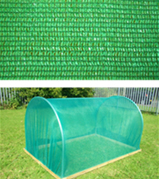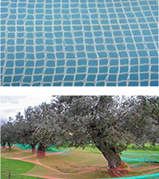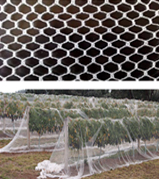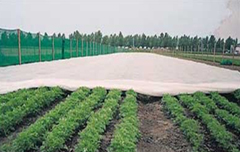Technical textiles are high performance, special textile materials and products that are manufactured primarily for their technical and performance properties rather than their aesthetic or decorative properties. ?Technical textiles are the fastest growing area of textile consumption in the world. Technical textiles can be divided into many categories, depending on their end use. Out of the twelve areas of technical textiles, agrotextiles is one of the growing areas of technical textiles. Agrotextile is the application of textile materials in agriculture field.
From time immemorial, the two most important human needs are food and clothing. In many developed as well as developing countries the area of land dedicated to agriculture and horticulture is declining. Thus putting immense pressure on the government to feed an ever-expanding population. There is continuous decline in the production of the crops in comparison with the increasing population. With the continuous increase in population worldwide, stress on agricultural crops has increased. So it is essential to increase the yield and quality of agro-products. However it is not possible to meet fully with the traditionally adopted ways of using pesticides and herbicides. Today, agriculture and horticulture has realized the need of tomorrow and opting for various technologies to get higher overall yield, quality and tasty agro-products.
India with its vast textile base, has the potential to grab a substantial share of the world market in the next few years time. Considering this emerging field, Ministry of textiles, Government of India has taken various measures to promote technical textiles and facilitate the growth and expansion of Technical Textiles. With this viewpoint, Ministry of Textiles, GOI has decided to establish various Centres of Excellence (COEs) for fulfillment of specific objectives in different segments of Technical Textiles.
The Centre of Excellence for Agrotextiles (COE- Agrotech) has been assigned to The Synthetic and Art Silk Mills’ Research Association (SASMIRA) as the lead agency jointly with other Agencies viz., The Man-made Textiles Research Association (MANTRA), Surat Navsari Agriculture University (NAU), Navsari as associate partner and Dept. of Textile Technology, Indian Institute of Technology (IIT), Delhi as knowledge partner.
The establishment and functioning of this centre has been initiated the year 2008 with the Office of the Textile Commissioner. The major activities under COE-Agrotech are Setting up of a Demonstration Pilot Plant, creation of testing and accreditation of laboratory, setting up of information centre and training centre. The centre also assist in entrepreneurship development and provide facilities for incubation centre and development and market research on new product prototype developed. Back to Top |
Agrotextiles Products
The areas of agrotextile application can be broadly identified as Agro-textiles for crop Production, Agro-textiles for Horticulture, Floriculture and Forestry, Agro-textiles for Animal Husbandry and aquaculture and Agro-textiles for Agro-Engineering related applications. Textiles in different forms are extensively used for many agriculture end uses that include knitted, woven, non-woven, extruded sheet, moulded product, ropes, belt, etc. The uses of non-woven especially spun-bonded fabrics are increasing. Few of the popular agrotextile products are shade nets, harvesting nets, nets for crop protection, mulch mats, textiles for food packaging, fishing nets, tarpaulins and their likes. Few of the other technical textiles that aid agriculture are geotextiles (soil covers), protective textiles (agriculture work wear) and industrial textiles (belts, hoses and filters).
Exhibition of Agrotextile products:
| Fishing? nets | |||
 |
Composition | : | Nylon monofilament, multifilament or HDPE |
| Constriction | : | Warp Knitted | |
| Advantage | : | Helps in fishing and fish farming | |
| Shade nets | |||
 |
Composition | : | Polyethylene tape Yarns or Monofilaments |
| Constriction | : | Warp Knitted | |
| Advantage | : | Low weight Acts like a sunscreen Protection against strong wind |
|
| Mulch mats | |||
 |
Composition | : | Jute, polypropylene, polyethylene |
| Constriction | : | Woven, non wovwn | |
| Advantage | : | Weed control around newly-planted trees and shrubs
Photodegradable Cost effective |
|
Harvest nets |
|||
 |
Composition | : | Polyethylene monofilaments |
| Constriction | : | Warp Knitted | |
| Advantage | : | Perfect for collecting fruits which fall off the tree when they are ripe Simplifies and reationalizes the harvesting process |
|
| Bird Protection net | |||
 |
Composition | : | Polyethylene tape yarns or monofilament yarns |
| Constriction | : | Warp Knitted | |
| Advantage | : | To Protech the fruits eaten by birds
Light weight Durable and strong |
|
| Anti – insect nets | |||
 |
Composition | : | HDPE monofilaments |
| Constriction | : | Warp Knitted | |
| Advantage | : | Insect net blocks the penetration of insects into the crop environment Reduces the use of pesticides, saving labour, time and money for the grower |
|
| Crop covers | |||
| Composition | : | Polypropylene | |
| Constriction | : | Woven, Non woen | |
Advantage |
: | Low wind sensitivity No excess water retention on the fabric surface UV stabilized Extremely strong Long lasting |
|
 Back to Top |
Market Potential Agro textile is one of the significant segments of technical textile products, occupying a significant place in terms of volume consumption. Worldwide growth of agrotextiles does not show a significant growth. With an improving economy and social scenario in India, a number of enabling factors are expected to positively impact the market for technical textiles. The growth drivers are emerging at both the supply and demand sides and include government support, increased investor interest because of the large untapped market, the way forward to ensure development of the sector lies in promoting international partnerships, training, implementation of policy support, focusing on product innovation, promoting awareness creation programmes and pursuing regulations and standardization of technical textile usage.
Two of the most important sectors where technical textile products have the potential of being used in significant volumes are agrotextiles and Geotextiles. It is expected that technical textiles will be increasingly used in both these sectors either due to increase in awareness or government regulations. The domestic agrotextiles market is expected to grow at the rate of 8% per annum.
The food security has become a major problem in India and worldwide that is accentuated by the threat of climate change. Some studies have revealed a Probability of 10 to 40% loss in crop production in the country due to the anticipated rise in temperature by 2050-2060. This is the underlying driving force behind the agro-tech sector, to improve and give better yield year after year.
 Back to Top |
Objectives
| To generate awareness about the potential of agrotextile products. | |
| To highlight the present global and domestic scenario of agrotextile industry. | |
| To disseminate information on entrepreneurship in agrotextile. | |
| To emphasise on the infrastructural requirement and the incentives from the government and financial institutes for usage. | |
| To increase awareness about the application of agrotextiles amongst end user industry. | |
| To highlight the Indian research on agrotextiles and activities of COE (Centre of Excellence) Agrotextiles. |
 Back to Top |



